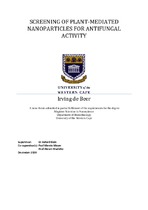| dc.contributor.advisor | Klein, Ashwil | |
| dc.contributor.advisor | Meyer, Mervin | |
| dc.contributor.advisor | Madiehe, Abram | |
| dc.contributor.author | de Beer, Irving | |
| dc.date.accessioned | 2021-03-09T12:42:38Z | |
| dc.date.issued | 2020 | |
| dc.identifier.uri | http://hdl.handle.net/11394/7955 | |
| dc.description | >Magister Scientiae - MSc | en_US |
| dc.description.abstract | Nanotechnology is spreading rapidly across the world as an extremely powerful technology. Nanoscience and nanotechnology are innovative scientific advancements that have been introduced only in this century. Nanotechnology has developed as the scientific advancement to grow and transform the entire agri-food area, with the potential to elevate global food production, in addition to the nutritional value, quality, and safety of food and food products. It has gained recognition due to its variability in shape, size, and dimension and how it correlates to its possibilities. One of those functions is nanoparticles’ (NPs) ability to have antimicrobial activity, more specifically its antifungal activity. One particular pathway of synthesising NPs is through phytonanotechnology which is the use of biomaterial to synthesis the NPs. | en_US |
| dc.language.iso | en | en_US |
| dc.publisher | University of the Western Cape | en_US |
| dc.subject | Antifungal activity | en_US |
| dc.subject | Antimicrobial activity | en_US |
| dc.subject | Dynamic light scattering | en_US |
| dc.subject | High-resolution transmission | en_US |
| dc.subject | Hydrodynamic size | en_US |
| dc.title | Screening of plant-mediated nanoparticles for antifungal activity | en_US |
| dc.rights.holder | University of the Western Cape | en_US |
| dc.description.embargo | 2024 | |

